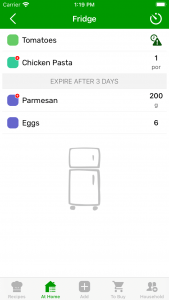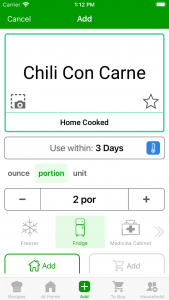
If you are into healthy eating, nutrition, or a waste-free lifestyle, you have inevitably come across meal planning advice. It is generously prescribed as a panacea to all our kitchen ills. Yes, that boring and incongruous act of planning 3 meals per day, for 7 days ahead, for n household members. We don’t know about you, but we never manage to stick to it for more than a week.
 Surely, you’ve also been advised to use those print-out tables (like the one on the left) ready for you to fill out every Sunday evening, ideally with your whole family involved, so everybody has a say. We wonder what you think of them, but to us, they are a recipe for failure and family frustration.
Surely, you’ve also been advised to use those print-out tables (like the one on the left) ready for you to fill out every Sunday evening, ideally with your whole family involved, so everybody has a say. We wonder what you think of them, but to us, they are a recipe for failure and family frustration.
We’ve been told over and over again that food planning is the vital first step to a waste-free kitchen. Even most anti-food waste apps base their solution on meal planning. But technology doesn’t make meal planning easier.
The problem with meal planning is that it just no longer fits our lifestyles.
Moreover, planning food in the “traditional way” has become a key driver of food waste in many modern households.
Meal planning was perfect when life was slow and predictable, and the family member had no other choice or obligations other than to eat their meals together at home each and every evening. But this is just not something that happens anymore. Our busy and unpredictable schedules take a huge time and energy toll on us.
We end up buying more than we can prepare, preparing more than we are able to eat, and throwing away way more than we have anticipated throughout the whole process.
Maybe you still mistrustful of what we are saying. You have been persuaded time and time again as to the virtues of meal planning. But here is the deal, answer the following questions in your mind as you read along.
These questions will help you make a realistic assessment of how our typical week looks like:

- Can we predict the number of family dinners we will be able to have at home this week?
- Are we positively sure that neither we nor our partner will have to attend an unplanned dinner in the next 5 days?
- Is there an upcoming family or friend gathering that has currently slipped our minds?
- Are we certain that we will have the energy to cook on Wednesday when the next meal preparation is planned? Are we likely to cheat with meal delivery?
- Can we be sure one of the kids won’t get sick and have no appetite?
If you’ve given more than 2 honest “NO” answers, it is not a cause for self-flagellation. It is time to admit that planning ahead is not a good fit for your family lifestyle. It is not a cause for despair but an invitation to try a different approach.
So what we need is an approach that actually works for us and fits into our busy schedules, unpredictable change of plans and our fluctuation in cooking energy and enthusiasm.
We would go as far as give a different name to this approach. How about daily Food Updating or daily Food Adjustments?
How Does Food Updating Work?
Scenario A
 Imagine it is Monday afternoon and you at the office. Nobody has notified about a change in plans. So by now, you are pretty sure you will all be eating dinner at home tonight. What to do next? Go through the food you already have at home. Note what ingredients, cooked meals, and leftovers you already have. Ah, but you are not at home; you are in the office.
Imagine it is Monday afternoon and you at the office. Nobody has notified about a change in plans. So by now, you are pretty sure you will all be eating dinner at home tonight. What to do next? Go through the food you already have at home. Note what ingredients, cooked meals, and leftovers you already have. Ah, but you are not at home; you are in the office.
No worry, our CozZo app gives you a precise, real-time snapshot of your home fridge and pantry. Let’s say you have some eggs, some tomatoes, some parmesan and enough pasta for 4 servings. You also have some chicken breasts that are approaching their expiry date, for which you got a strict reminder and a red flag from the CozZo app, that they need your attention today.
Poultry meat is highly perishable food. You bought the breasts last Friday with the idea to make chicken curry over the weekend. But you had to cancel your Indian fiesta plans because you forgot about this family gathering at your in-laws.
But now, in turn, you almost forgot about the breasts – there are just too many things on your mind. You were thinking about a simple pasta. But now that you’ve checked you quickly google a pasta and chicken breast recipe. It says broccoli and sour cream. You just add those two items to your CozZo app “to buy” list, and head for the store after work to catch up on just those two items. Fast, easy, and efficient.
You’ve made use of what you have and did not buy any excess food for tonight. You didn’t manage your initial plan for chicken curry. But you made adequate adjustments with the smart inventory update and buying only what you needed.
Scenario B
 Now imagine it is Tuesday. Your partner is attending a business event and won’t be home for dinner. So it is just you and the kids. You have some leftover chicken pasta from last night, but it won’t spread to 3 serves to feed you all.
Now imagine it is Tuesday. Your partner is attending a business event and won’t be home for dinner. So it is just you and the kids. You have some leftover chicken pasta from last night, but it won’t spread to 3 serves to feed you all.
But checking the CozZo app, you are reminded that you have 6 eggs and still some parmesan. You also see that the tomatoes are marked with a green flag. This means that they are starting to lose their flavor but are still good.
If you use the leftover pasta as a base for a tomato frittata, you can skip the grocery tonight. You can head straight home after work, for a quick dinner fix and enough quality time with the kids.
Scenario C
Now think – it is Wednesday today. You finally decide you will be cooking a meal from scratch as your fridge is almost totally empty by now, (good job, by the way). You go through your favorite family dishes and choose the one you haven’t prepared in a while. You only need a few moments to add the ingredients to your CozZo app, so when you enter the store you will be shopping with intention. No idle wandering around the aisles with no dinner concept in mind.
 As you do not plan on cooking again tomorrow, you’ve planned for more serves to last you until Friday. Or maybe your family is of the picky type that prefers a new dish every night. In that case, you freeze the extra portions. But in order to avoid the UFO scenario, the unidentified frozen objects in your freezer, you can make a new entry in your “At Home” catalog, say chili con carne.
As you do not plan on cooking again tomorrow, you’ve planned for more serves to last you until Friday. Or maybe your family is of the picky type that prefers a new dish every night. In that case, you freeze the extra portions. But in order to avoid the UFO scenario, the unidentified frozen objects in your freezer, you can make a new entry in your “At Home” catalog, say chili con carne.
Next, assign the exact number of the extra portions that you will be freezing or storing in your fridge. By choosing the category “Home Cooked” CozZo.app will automatically suggest 3 days as a standard shelf-life for refrigerator storage. If you plan on freezing, then you can manually assign 1 month or longer to your entry. You can also take a quick picture of the meal with your phone camera. Attach it to the entry as an inspiring reminder for future references.
There you are, You are totally updated with your food inventory at home. So now, you won’t forget those cooked meals that are sitting in the lidded cooking pots in the fridge.
So that is our take on food planning. A simple and straightforward approach. And above all, one that is accommodating your lifestyle and schedule instead of fighting with or against it.


Comments are closed, but trackbacks and pingbacks are open.